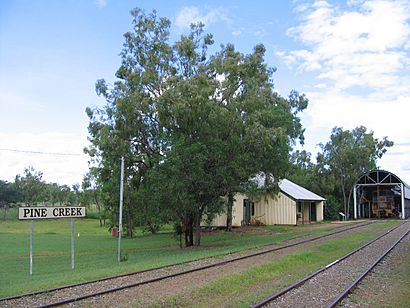Pine Creek railway station facts for kids
The Pine Creek railway station is an old train station in a place called Pine Creek in Australia's Northern Territory. It's not used for trains anymore, but it's now a cool museum! This station was once part of the North Australia Railway. It is about 235 kilometers away from the original Darwin station. For many years, until 1914, Pine Creek was the very end of the train line. Today, the station area is the best example we have left of how this old railway used to look.
Contents
A Look Back at Pine Creek Station
Building the Palmerston and Pine Creek Railway
The train line from Palmerston (which is now Darwin) reached Pine Creek in 1889. This made it much easier to get to the goldfields from Port Darwin. However, by the time the railway was finished, the local gold mining was already slowing down.
The station yard was built with two "sidings." Sidings are extra tracks where trains can wait or be loaded. Each siding could hold 42 goods wagons. This was planned for lots of future train traffic.
Early Train Services
Trains carrying both people and goods started running on October 1, 1889. These trains were managed by the Palmerston part of the South Australian Railways. They were pulled by powerful "W" class steam locomotives.
Three trains a week came to Pine Creek. They arrived in the evenings on Monday, Wednesday, and Friday. They left the next morning at 8 am to go back to Palmerston. The whole trip took about nine and a half hours. There was even a stop at Adelaide River for refreshments.
Train Tickets and Costs
A first-class ticket from Palmerston to Pine Creek cost 4 pence per mile. A second-class ticket was 3 pence per mile. This was quite expensive! People even complained that the passenger cars felt more like they were for animals than for people.
Moving heavy goods and machinery by train was also costly. Many thought the prices were too high to help the mining industry grow. This was true even though the railway was built mainly to support mining.
Commonwealth Takes Over and Expands the Line
In 1914, the Australian government took control of the Northern Territory and its railway. The train line was then extended to Emungalan. This town was on the north side of the Katherine River. The extension helped the cattle industry, moving cattle to meatworks in Darwin.
Pine Creek remained an important station even after the line was extended. New sidings were added to the station. In 1918, Commonwealth Railways became responsible for running the station. The train ride from Pine Creek to Emungalan took about three hours. By the 1920s, trains going south ran only once every two weeks. Trains going north ran once a week.
Plans for a Transcontinental Railway
Even with fewer services, the government approved another extension south to Daly Waters. At the same time, a narrow-gauge line was extended from Oodnadatta, South Australia to Alice Springs. The big dream was to connect these northern and southern lines. This would create a railway across the entire continent!
However, the Great Depression hit in 1929. This economic crisis stopped the northern line's construction at Birdum. This was about 70 kilometers short of Daly Waters. In 1926, the line was renamed the North Australia Railway. Pine Creek was no longer the end of the line, but it was still a place where trains stopped overnight.
Pine Creek Station During World War II
When Australia joined World War II, many military bases were set up in the Northern Territory. The railway became a super important way to move supplies and soldiers. In 1939, only one train a week stopped at Pine Creek in each direction.
By 1941, several trains a week stopped there. This number grew even more, reaching 147 weekly services by 1944! The station became a major base for distributing supplies during the war.
The Pine Creek Railway Museum
Today, the Pine Creek station area is a museum. It's a great place to learn about the railway's history. You can see a restored steam locomotive from 1877. This "NF class" engine was used to help build the railway. There's also a diesel-electric shunting locomotive that is kept in working order.
Many of the original station buildings are still there. These include the old passenger station with restrooms, a parcel office, and a waiting room. You can also see the goods shed, a loading bank, a weighbridge, and a crane.
Some other railway buildings were removed after the line closed in 1976. But the site was added to the Register of the National Estate in 1980. This meant it was important to protect. Since then, the remaining buildings and equipment have been carefully restored. The station area was also listed on the Northern Territory Heritage Register in 1994.


